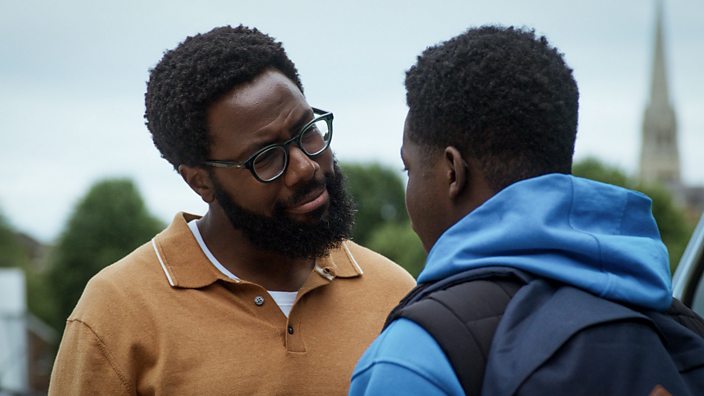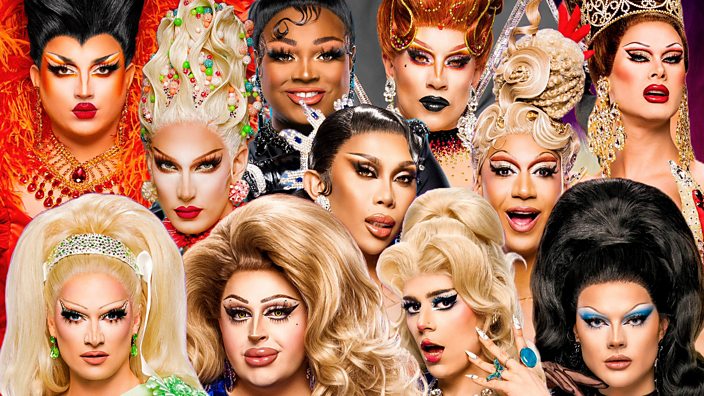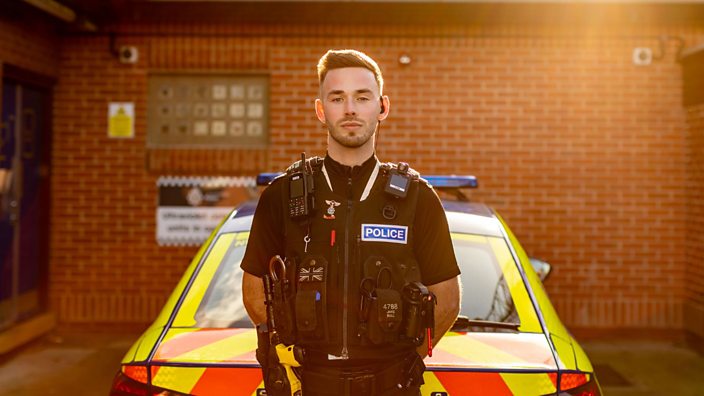 BBC Three
BBC ThreeThe Left Behind: What makes young people join the far right?
A new BBC Three drama tells the story of a disenfranchised young man drawn to the far right. But what attracts people to extreme ideology?
A plant pot flies up into the air and seems to hang there, just for a moment, before it comes crashing down amid 300 English Defence League (EDL) supporters making their way through Walthamstow in east London. It's September 2012, and a large group of counter-protesters – some reports suggest there were thousands – block the route of the march. As the police struggle to keep the two groups apart, objects fly between them. The EDL make their way past the terraced houses and eventually gather in a back street, where they are stopped by the police.
Just up the road, hundreds of counter-protesters have broken through police lines, reportedly hurling bricks at EDL leader Stephen Yaxley-Lennon – also known as Tommy Robinson – who is waiting, with a sound system and a gazebo decked in EDL flags, for the march to arrive. The march never reaches him. The police divert the EDL crowd back through the suburbs of Walthamstow to the tube station they arrived at. As they are slowly escorted through the streets, jubilant youths celebrate their departure on the roof of a block of flats.
As the march is brought to a standstill, police arrest nine EDL supporters and 11 anti-fascists (more arrests were made where the protesters were not taken into custody).
Among those arrested was sociologist Hilary Pilkington, who was there as an observer. It was only her third EDL protest. Getting arrested on what EDL activists widely called “the worst demo ever” (on account of them being pushed into a humiliating retreat by the anti-fascist counter-march), led to her getting to know a group of EDL supporters. For the next three years, she accompanied them to protests, to conduct an in-depth study on what attracts people to the far right.
Professor Pilkington also worked as an adviser on the new BBC Three drama The Left Behind, using her experiences to inform the fictional story of a young man from Wales who, faced with homelessness and job scarcity, and angered by his perception that Muslim families were being given housing before local residents, turns to the far right with devastating consequences.
In Prof Pilkington's opinion, some people are drawn to the far-right because of anti-Muslim prejudice. “People have a very strong sense that there is something changing in this country and it’s to do with the growing visibility of strong religious practices. It's more visible than they’d expected it to be, without a big conversation about it,” she says.
Anti-fascist group Hope Not Hate's annual report, the latest of which was released this February, claimed that 35% of Britons thought Islam was a threat to the British way of life. The report claimed, "The terror attacks of 2017 have had a profound impact and concerns about Muslims and Islam in Britain have hardened."
 BBC Three
BBC ThreeWhen Prof Pilkington started spending time with activists, the EDL was beginning to splinter into regional movements. It became even more fragmented when Yaxley-Lennon left in 2013, citing concerns over, what he called, the “dangers of far-right extremism”. This caused him to fall out of favour with some activists, and the group continued to dwindle, with fewer people turning up to street protests. Yaxley-Lennon admitted in his autobiography that he and other EDL figureheads "hadn’t a clue how to develop" the group from street demonstrations into a political force, and some researchers have said the lack of organisation led to its decline.
Speaking to the New Statesman in 2017, Prof Pilkington noted how, at an EDL rally in Birmingham that year, police let counter-protesters walk right up to EDL members, when in previous years they'd worn riot gear and kept the two sides apart. She estimated there were up to 150 EDL demonstrators at that rally, compared to approximately 1,500 at a march she attended in 2013. Prof Pilkington observes that other far-right organisations, like Britain First, stepped in to fill the gap left by the EDL and attempted to appeal to supporters who felt betrayed by Yaxley-Lennon’s departure.
The EDL's influence might have decreased, but the consequences of being drawn to far-right ideology can sometimes be deadly. In May 2019, Jack Renshaw, 23, was jailed for life for plotting to murder the Labour MP Rosie Cooper. He had posted online praising the murder of Jo Cox, and was linked to the banned neo-Nazi group National Action. In June 2016, the Labour MP Jo Cox was murdered by the Nazi-obsessed Thomas Mair, then 53, and almost exactly a year later, Darren Osborne, then 48, drove a van into a crowd of Muslims outside a North London mosque, killing one and injuring nine others. His trial heard how he had read posts by Yaxley-Lennon on Twitter, and that the internet had exposed him to "anti-Islamic ideology". Yaxley-Lennon said he had never had contact with the killer.
Yaxley-Lennon himself has seen something of a resurgence lately by turning his attention to Brexit – he appeared at a UKIP-led ‘Brexit Betrayal’ march in December 2018, which a spokesperson said attracted a “few thousand” people. Shadow chancellor John McDonnell accused Yaxley-Lennon and his supporters of co-opting Brexit to spread far-right rhetoric, saying: “This march isn’t about Brexit, it’s about far-right extremists dressing up in suits and pretending to be respectable.”
As well as anti-Islam sentiments, Prof Pilkington found that another motivation for people joining the far-right was a feeling they were becoming “second-class citizens”, particularly because of difficulties accessing social housing. Allowing people to buy their council homes led to around two million properties in England being sold to their tenants between 1980 and 2014. The latest local authority housing statistics show that, at the start of April last year, there were just over 4 million homes in England being used as social housing, with just over 1 million households on council waiting lists waiting for homes to become available.
 BBC Three
BBC Three“When you’re fighting for social housing, it’s really tough,” says Prof Pilkington. “The way people bid on homes means they can see who else is on the list, and who the properties are being awarded to. That led to a lot of confirmation for people that newcomers – people who were coming in, either to the area or the country – were being prioritised on the housing list even though the locals' needs were, as far as they were concerned, just as great.”
When people apply for social housing through their local councils, if they are accepted, they go onto a waiting list. The council then prioritises people based on who needs a home the most urgently, so being on a waiting list isn't a guarantee of getting a home. Some councils have online systems where people on the waiting list are able to bid for a home. Bidding for social housing means multiple people all bid for the same home and then the council offers it to the person who they think needs it the most.
One of the EDL activists Prof Pilkington met found it difficult to get a council home, and felt that experience was partly what pushed her into politics. Tina,* who was 31 and studying at uni when she met Hilary, told her how she joined the EDL after the brutal murder of the solider Lee Rigby at the hands of two radical Islamists in London in 2013. “That’s the first time I’d heard of the EDL… I looked them up on Facebook. I liked their page, found out about the Birmingham demo [to commemorate Lee Rigby's death], and me and my partner went.”
The EDL were accused of exploiting the soldier's tragic death to boost support for their cause.
Tina spent 10 months living in her parents' three-bedroom house, with her three children, her mum, her brother, his two children and her dad, who was suffering from terminal cancer. Tina told Prof Pilkington: “So I was on that bidding site. Ten months I had to live at my mum’s house in that one bedroom that was full of mould, and damp, and I was always second on the bidding list, and the number one always has first refusal. Every single property that I went to view, Somalians got it, you know, and I was thinking… my kids have to watch their granddad die, do you know what I mean? The house was totally overcrowded.”
“Migrants would not have anywhere else to go,” explains Prof Pilkington. “You can see why that would put them higher, but for her, it felt that first you look after the people that are already here who are in very difficult circumstances, and then you might offer people who are coming in somewhere to stay, so that made some people feel very frustrated.”
Most of the EDL activists Prof Pilkington met were unemployed or in precarious jobs which didn’t pay a lot, or regularly. She says many had dropped out of school, so had never fulfilled their academic aspirations. Younger activists complained to her about how difficult they found it to find work.
 BBC Three
BBC ThreeOne EDL activist Prof Pilkington met, Declan,* who was in his late teens and living with his parents, had just lost his job at a DIY superstore and was living on benefits. Competition for jobs in his local area was tough. Declan’s dad had been unemployed for over a decade and his mum hadn’t worked since he was a child. “If there’s one job advertised there’ll be 900 people applying for it and only 10 will get an interview,” Declan told Hilary. He’d applied for over 50 jobs, some of which his own parents were also trying to get.
Teesside, where Declan is from, had an unemployment rate of 7.1% in 2018, with a rate of 8.3% for men, well above the then-national average of 4.2% (it has since fallen to 3.8%). The area used to have a lot of jobs in heavy industry but as plants close and factories shut their doors, large numbers of people have become unemployed. The North East is also the part of the country with the highest number of referrals to the Government’s Prevent strategy for concerns about right-wing extremism: of the 1,312 individuals referred to Prevent for this reason between 2017 and 2018, 249 (19%) were from the region. Over the same time period, there was an increase of 36% for referrals related to right-wing extremism in general on the year before.
The internet has also become a key tool which the far-right use to spread their ideas and recruit people from left-behind areas, according to Julia Ebner, a research fellow at the Institute of Strategic Dialogue, who specialises in monitoring far-right extremism. “One of the biggest factors far-right groups have been exploiting online are socioeconomic grievances.” They do this by pushing their messages out on various online platforms, but also through things like encouraging others to join in harassment campaigns, says Julia.
Julia explains that a strategy used by some far right groups is to find issues that concern people, like a lack of access to social housing or a decline in high-quality jobs, and tell them they are caused by things like immigration or the growth of Muslim populations. “They've tailored some narratives to fit these grievances and added their ideologies to explain these sentiments, and that's often combined with anti-establishment conspiracy theories,” Julia adds. The ‘white genocide’ and ‘Great Replacement’ conspiracy theories are an example of how the far-right try to use changing demographic trends to push their messages. These theories appear to have motivated the alleged Christchurch Mosque shooter, accused of killing 51 Muslims during their Friday prayers, who repeated them in his ‘manifesto’.
These narratives can resonate with some people in ‘left-behind’ communities – places where people feel their needs have been forgotten and overlooked – who are looking for answers to the problems and issues that they’re facing. Azim Ahmed is a research associate at Cardiff University who previously worked with young people in South Wales around the issues of far-right extremism and child exploitation.
“The far-right makes the type of violence they're going to commit meaningful, in terms of targeting minorities,” Azim explains.
There are a number of different ways to try to pull young people away from the far-right. Azim says a key part of doing this is creating support structures in communities. Things like church or Mosque groups, trade unions or boxing clubs all bring people together and support the members, giving them people to turn to when they face difficulties, while also building a sense of community and a shared identity.
 BBC Three
BBC ThreeAnother way is changing the stories we tell each other about who we are and making it easier for people to see through the myths and conspiracy theories being spread by the far-right. Azim was formerly a youth worker with the Ethnic Minorities and Youth Support Team (EYST), who would go into schools and talk to young people about the issues they were facing, hoping to intervene before people were attracted to the far-right.
The challenge, according to Azim, is to try and push the discussion towards a completely new framing. One key thing which needs to change is how we talk about migrants. “Instead of thinking how do we naturalise or integrate migrants,” Azim says, we need to recognise “there is this incredible diversity in Britain already, even among the white British community.”
Azim says the narrative far-right groups like National Action and the EDL are deploying, that British society is under threat from other cultures, is “very powerful and evocative” and he thinks society needs to be challenging it directly. “It's very important we get a counter-story which brings in a wider sense of belonging and a sense of Britain which is inclusive and recognises how minorities are part of the landscape,” he says.
“Until we do that we're always going to be at risk of having the far-right story win some people over.”
The Left Behind is available on BBC Three iPlayer now
* Some names have been changed.















